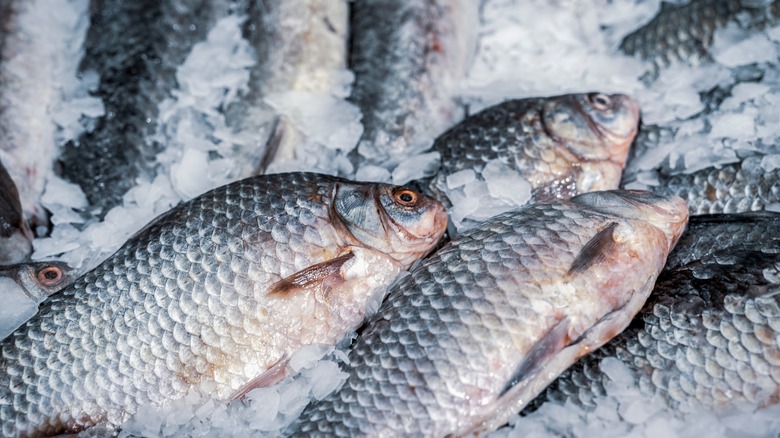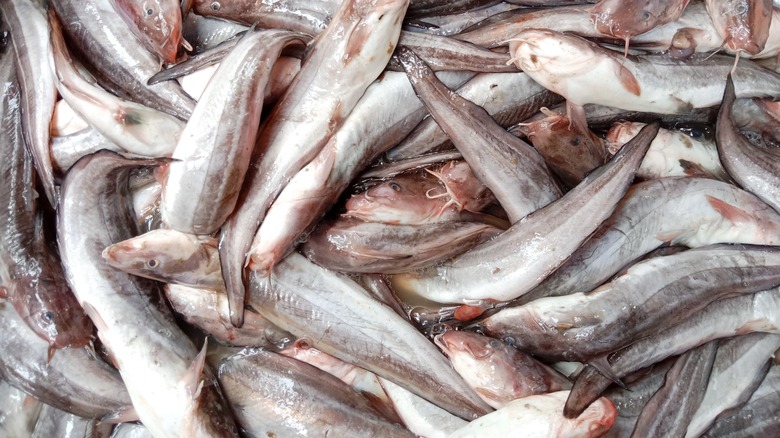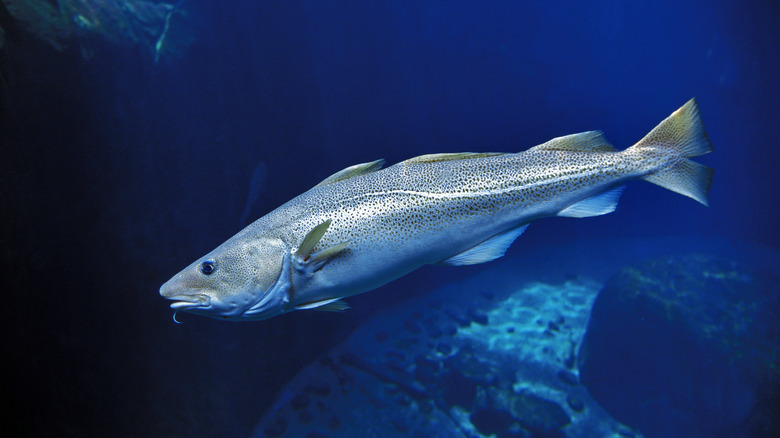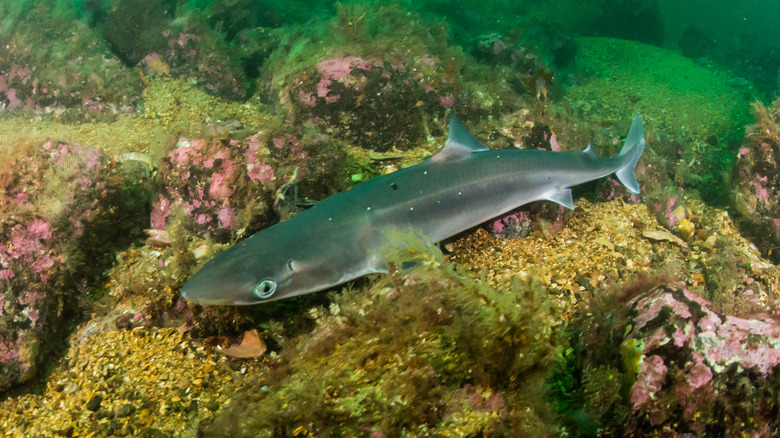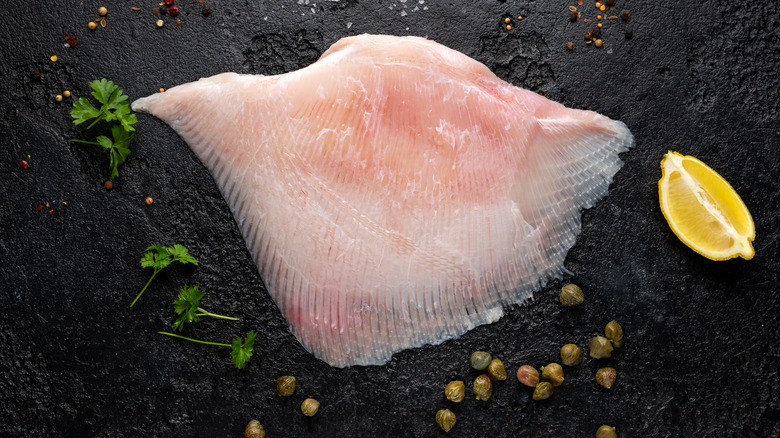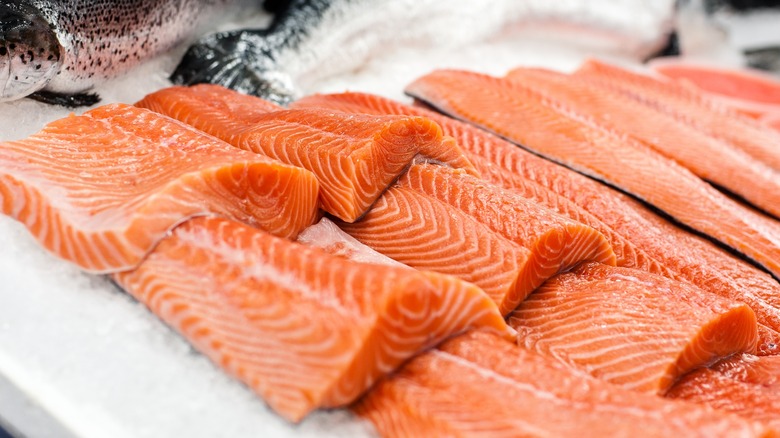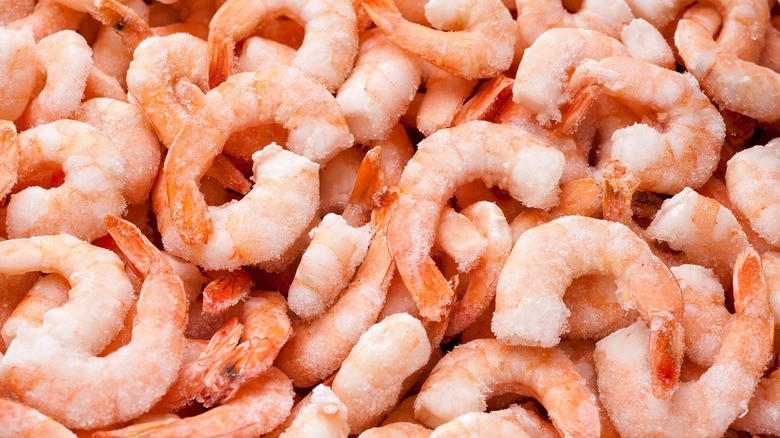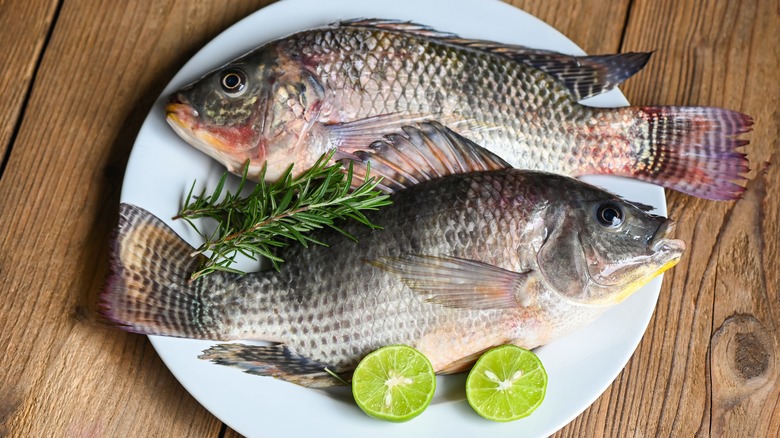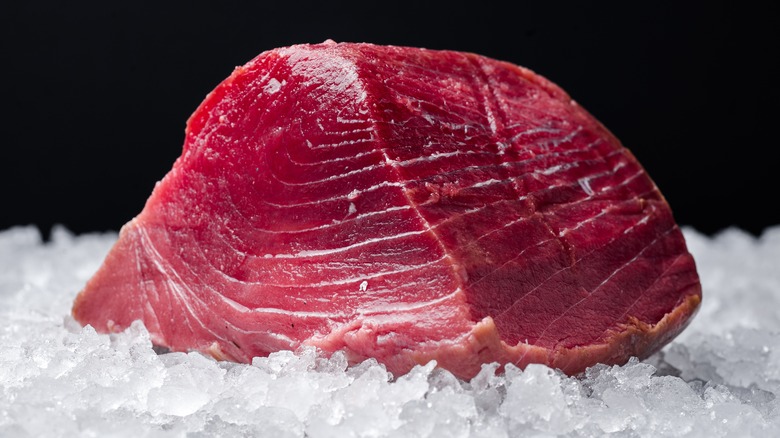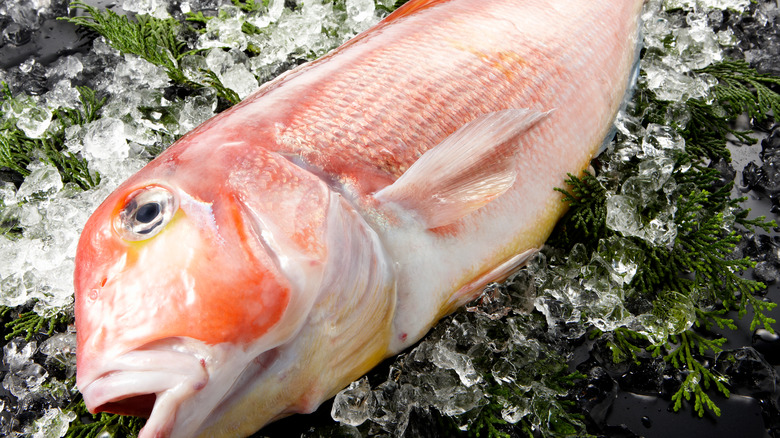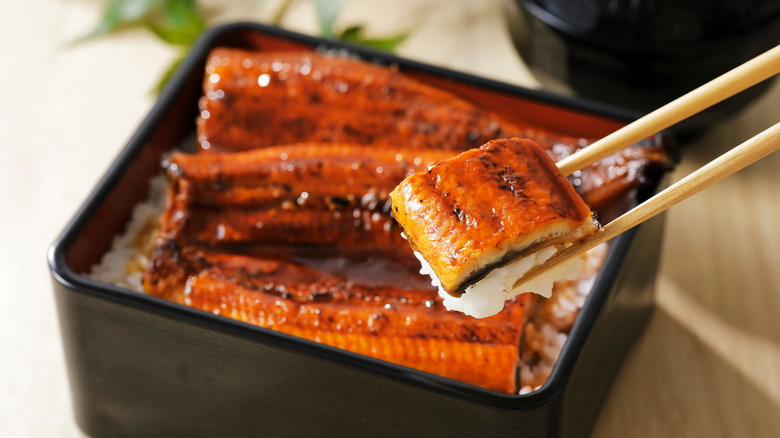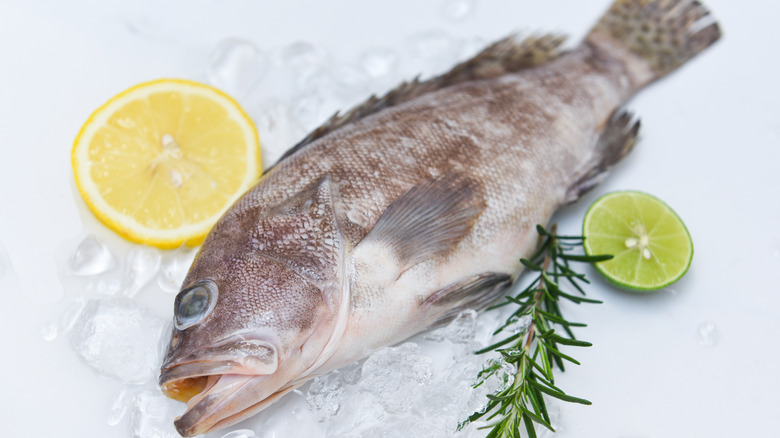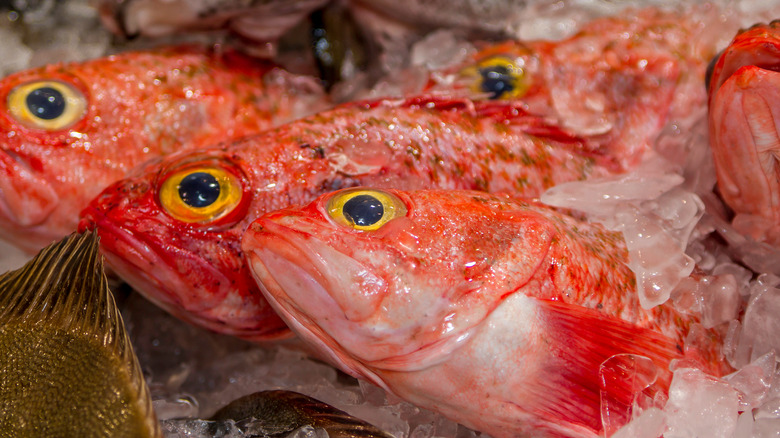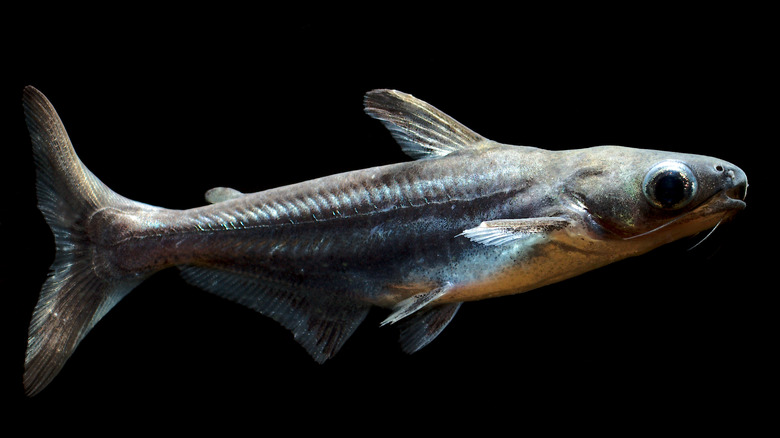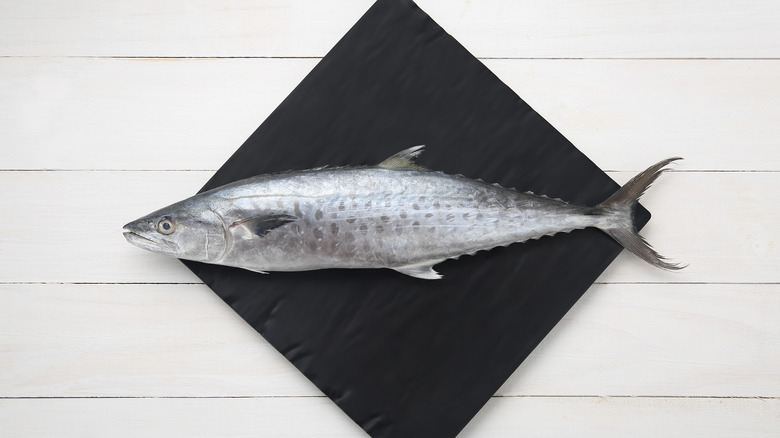14 Cheap Fish You Should Always Avoid Buying
The size of the seafood market in the United States is almost as big as the Atlantic Ocean itself. Okay, we're slightly exaggerating there. But there's no denying that Americans eat a lot of fish. The approximate revenue for the U.S. fish and seafood market in 2023 is a staggering $28 billion, and that's set to rise almost 3% year-on-year, per Statista. On average, we each spend over $83 annually on this type of food. Plus, as many species out there are cost-effective, that number can equate to a fairly large amount of fish.
But, in some cases, the price of fish can be a little too good to be true. As time has gone on, the demand for fish has increased exponentially, and this has led to arguably some questionable production methods. Whether it's because of their mercury levels, their potential to be overfished or farmed, or some eyebrow-raising practices around imported fish, many seafood items out there are cheap for a reason. Those reasons, which often aren't great, are what we're gonna reveal to you right now. Read on to discover 14 cheap fish you should always avoid buying.
1. Imported catfish
Catfish is perpetually popular in the U.S., and as many Midwestern and Southern dishes are centered around this type of fish, it's little wonder that demand is high. This demand has understandably led to an outsourcing of catfish production to other countries, and an increase in imported catfish to the U.S., which may well be cheaper than locally-caught options.
Unfortunately, though, these fish, which are sometimes caught in places such as Vietnam and China, are best avoided. The different fishing and environmental practices in these countries can lead to their catfish containing substances that you may not find in fish caught in the U.S., with some catfish found to contain pathogens or chemicals that could create hazards. In Vietnam specifically, fish and shrimp farms may use antibiotics, with almost two-thirds of all fish farms surveyed in a study published in Aquaculture Reports using them on their fish. The study found that some of these farms were even using antibiotics that are prohibited in fishing farm practice.
Now, consuming antibiotics from fish isn't necessarily inherently harmful. But the trouble lies in the fact that the mere use of antibiotics in large numbers of fish can breed antibiotic resistance, according to Arizona State University Center for Environmental Security's Hansa Done (via Time). Probably best to skip that imported catfish, and stay local.
2. Atlantic cod
Cod is a popular form of white fish, and as anyone who's ever had a filet of cod as part of a traditional fish and chips will tell you, it's pretty tasty. But all of that demand for cod, and Atlantic cod in particular, has put it in peril. Atlantic cod has always been fished consistently throughout history, but in recent years, as technology got better and people got hungrier, the demands of the fishing industry reached a fever pitch. This led to a breakdown in the late 1990s, with the Atlantic cod population plummeting, as demand outstripped supply.
This breakdown led, luckily, to a recognition that things had gone too far, and pulling back on the fishing of Atlantic cod. But while things have improved a little, the situation still isn't great. Atlantic cod populations are still significantly reduced because of these practices and are recognized as being vulnerable, potentially because of the imbalance that was caused by all that fishing, which allowed other fish to gain dominance in these environments. To protect this fish species, it's best to avoid Atlantic cod and to look instead for cod that has been sustainably sourced. This can be designated by a blue MSC label on its packaging, which refers to the Marine Stewardship Council, an organization that vets sustainability in the fishing industry.
3. Rock salmon
Rock salmon, also known as spiny dogfish, is a pretty prevalent fish. This mid-sized sea-dweller can be found off coasts across the entire globe, and it is fished in a wide variety of places. Its ability to thrive in many different types of waters may have led to the fish becoming cheap and popular. In some places, like in the Northeast Atlantic, rock salmon is classified as critically endangered by the International Union for Conservation of Nature.
Part of this is down to the fact that rock salmon isn't just used for human food, but can also be found in pet food, or used for non-culinary purposes, like in dietary supplements or for farming. But the heavy demands placed on this fish are not the only reason why you should give it a wide berth. Pregnant people may want to avoid or limit their intake of rock salmon because it's more likely to contain pollutants, according to Baby Centre. It's recommended that you don't eat more than two servings per week of rock salmon if you're pregnant.
4. Skate
The skate is a rather incredible-looking fish. Similar in appearance to stingrays, they're usually harvested for their wing meat. While skate wings can reach high prices in fancy restaurants, they can be pretty cheap and readily available at your local fish market.
All this might seem like a recipe for a perfect, cost-effective fish dinner out there. Except for the fact that skate is quite a tricky fish to be eating on the regular. The main reason is that unless you know what you're doing, it can be a total nightmare to prepare and cook properly. While most fish is best when it's at its freshest, skate wing can be way too chewy and dense if it's cooked too soon after being caught, Eric Ripert, chef and owner of the celebrated New York City restaurant Le Bernardin, told The Washington Post. But leave it too long and it'll go off fast, thanks to skate's ability to turn rancid quickly, according to Dave Pasternack of the restaurant Esca.
That's not the only reason you should avoid skate, though. The fish bears a higher-than-average potential for toxicity, thanks to its biology and mechanism for excreting waste through its skin (via Fish Masters). If you detect an ammonia smell at all when handling skate, it's a telltale sign that it's not safe for consumption.
5. Farmed salmon
Salmon is truly the cool kid of the fish world. We get it. Salmon is delicious, it's good for you, and it's comparatively less pricey than a lot of other fish out there. But, of course, when something gets popular, methods are put in place to make it more available. With salmon, the popular method is the creation of salmon farms. These salmon farms can have a significantly negative environmental impact, one that only keeps growing as the fish becomes even more desirable. Salmon farming is increasing in size faster than any other food production method worldwide, and when you buy farmed salmon, you somewhat feed into its growth.
It's also worth remembering that compared to wild-caught salmon, farmed salmon can have increased levels of pollutants in the form of polychlorinated biphenyls (PCBs), a type of chlorinated chemical. The concentration of PCBs in farmed salmon is higher because the water that they live in is simply less mobile and fresh than the habitat of their wild siblings. While farmed salmon can still be nutritious, it's a good idea to try and buy wild-caught. "I recommend looking for wild salmon and other seafood out of Alaska, which supplies 95 percent of the wild salmon in the U.S. Studies have also shown lower levels of PCBs in wild salmon from the glacier-fed waters of Alaska versus other areas, like Ireland and Scotland," registered dietitian nutritionist Frances Largeman-Roth told Livestrong.
6. Imported shrimp
Even people who find some types of seafood a little "too fishy" love shrimp. It's arguably one of the most versatile types of seafood out there. It can also be found at virtually any supermarket across the land. But part of the reason why shrimp can be so affordable is because it may be imported from other areas. However, imported, often farm-raised shrimp can have a seriously negative impact.
One of the main problems with imported shrimp is the consequences it can cause to the environment. Every nine out of ten pieces of shrimp eaten in the U.S. comes from a different country. This is part of what makes the shrimp industry on the environment up to ten times worse than beef production. Shrimp farming — in certain countries that export heavily to the U.S. — has also been linked to human trafficking. To make matters even worse, shrimp farms in other countries may not be subject to the same standards around antibiotics that the U.S. aquaculture industry is.
7. Tilapia
It feels as though tilapia was once a relatively unknown fish, but nowadays, you can find it on menus fairly easily. Sometimes called the "aquatic chicken," the recent boom in tilapia popularity has been associated with the fact that it's relatively easily reared, and can be potentially less harmful to the environment than other fish production. Plus, it's also pretty cheap. If that's the case, then what's the problem?
Well while tilapia is easy to find and cook, the fact remains that it may not be as good for you as you think. Fish is commonly thought to be objectively good for you. But the fatty acids that people prize so highly in fish like salmon come in different forms. According to a study published in the Journal of the American Dietetic Association, tilapia, as well as catfish, are higher in more harmful saturated fatty acids. These fishes can also be lower in beneficial polyunsaturated fatty acids. As such, eating tilapia more frequently could put you at greater risk of health conditions associated with higher consumption of these fats, including inflammation and all of the health concerns that can come with it, per Healthline.
8. Tuna
Suggesting that everyone stops buying tuna — arguably the most popular and easy-to-prepare fish out there — is a bold move, to say the least. But there are some very good reasons why you should skip the canned tuna aisle in favor of some other fish varieties. The first is the sheer repercussions that widespread tuna consumption has had on its population levels. Pretty much every type of widely-available tuna is overfished, with some types, like bluefin tuna, now being critically endangered. Other species, like albacore and yellowfin, are suffering from increased pressure and dwindling populations, with stocks not being replaced as fast as they're being fished.
On top of that, there's also the big "M" word to consider: mercury. Tuna is pretty well-known for having high mercury levels, like a lot of other seafood out there. But it's also useful to remember that mercury exposure that can occur from eating too much tuna is no joke. High levels of mercury from overconsumption of mercury-high seafood can lead to problems with your heart, cognitive functions, and mental health, according to Healthline. If you're going to buy tuna, it's best to limit your consumption of it as much as possible — both to play a small part in reducing the impact of overfishing and to stay healthy.
9. Tilefish
Tilefish may not be the most popular fish out there, but people love it every now and then. For one thing, tilefish is fairly cost-effective. Plus, it has a gentler taste than a lot of other fishes out there, more similar to crab meat than some stronger, brinier fish varieties. This is partly thanks to the tilefish's diet, which is crustacean-based.
But if you're thinking that tilefish sounds like the ideal choice for dinner, think again. Tilefish in the mid-Atlantic faced a lot of pressure from an increase in fishing, and while things are getting better, there are still concerns about overfishing and a repeat of the same issues further down the line.
As well as this, tilefish are almost astonishingly high in mercury. Tilefish caught in the Gulf of Mexico have the most extreme concentrations of the metal of all the types of seafood tested by the U.S. Food and Drug Administration. It's recommended that if you're going to eat tilefish, you should have no more than one serving per month, to keep things on the safe side.
10. Eel
Eel may not be your first choice for seafood at home, but if you're eating in a sushi place, it's hard to pass up. Grabbing an unagi bowl in your local sushi restaurant can be a reasonably-priced way to fill up. But there's a key reason why you might want to forego ordering eel in the first place, especially if you're eating in a joint you're not familiar with: it may be illegal.
When unagi is served in Japanese restaurants or sushi establishments, it's typically Japanese eel. But surprisingly, research published in Food Control found that the eel being served in certain places is, in fact, the European eel — which is against the law to import, due to its critically endangered status. The study looked at 114 samples of eel and a large proportion of the seafood analyzed was of European origin. "It's really suggestive of some sort of illegal sale and links to illegal trafficking of live eels to Asia," lead study author and lecturer in biological sciences at the University of Exeter Andrew Griffiths told USA Today. Since this fish species is so vulnerable, it may eventually disappear entirely if activities like this persist.
11. Grouper
The grouper fish may not be the best-looking sea-dweller out there, but there is a lot to love about its culinary applications. However, one thing about grouper is that it's pretty pricey. Groupers generally live in slightly deeper waters. As such, it can be difficult to get to and fish efficiently, leading to a higher price point than other seafood.
If you see a grouper on the menu that's cheap, you might feel like you've struck gold. Until you learn that what you're ordering might not be grouper at all. Pangasius, an easy-to-farm relative of the catfish, can often be sold under the names of different fish, like grouper or sole. Because pangasius is so cheap and plentiful, morally dubious fish suppliers can take advantage of its extensive availability and market it as other types of food. Grouper is one of the fish it's most commonly sold as. For this reason, if that price feels too good to be true, it's probably because it is.
12. Orange roughy
The orange roughy is one of those fish that can feel like you've struck the jackpot when you've found it. This is mainly to do with the fact that it's not commonly available and yet still relatively inexpensive, so lovers of more niche seafood might jump at the opportunity to take some home.
We'd recommend against doing so pretty enthusiastically, though. The orange roughy — also known as the slimehead, unfortunately — is pretty endangered. Buying it only feeds into this problem. Orange roughy populations have taken a serious hit in recent years because they have such a long lifespan, with some living almost 150 years. Unfortunately, this means that they can take far longer to mature and reproduce. The fishing of this species has reduced the population faster than it can restock itself.
Additionally, the orange roughy has one more troublesome thing about it: Its mercury content. This fish has a pretty high concentration of mercury in comparison to other types of seafood, largely because of its long lifespan, which gives it the ability to absorb and build up more mercury as time goes on, according to the Canadian government's website. Between that and the impact your purchase could have on its population, it's best to give the orange roughy a wide berth.
13. Swai fish
Swai fish, also known as pangasius, is common in the U.S. But this is because it's usually used as a substitute for other types of fish. One study even found that many grouper, catfish, and basa dishes are actually swai fish instead (per Food Control). This is a dubious practice at the very least.
If you happen to find swai fish on a menu, or in your local supermarket, it's probably best to skip it — even if it is being branded properly. Not only might you be feeding into morally shady practices by buying it and supporting the swai fish industry, but you may also be buying a form of fish that has limited quality control around its production. Swai fish is often reared in farms in Vietnam, and these farms can often be kept in conditions that are sub-par. Therefore, the swai fish raised there could be more likely to have harmful microbes, contamination from chemicals, or a higher antibiotic amount than you'd find in non-farmed fish. It's no wonder that this fish is more affordable than most.
14. King mackerel
The King mackerel might have a pretty grand name, but there's nothing that impressive about this fish. King mackerel is an affordable option for those who are looking for a stronger-tasting fish that can be used in a variety of different meals, so we can understand why it remains attractive to consumers.
But if we were you, we'd lay off this fish. King mackerel has a long lifespan — some of them can live upwards of 20 years. This length of time gives them plenty of opportunity to absorb bucketloads of mercury from the water, which then permeates the fish's flesh, and makes its way onto your plate. Along with tuna and swordfish (fish that also have a longer lifespan), King mackerel has a high heavy metal concentration and should be eaten in moderation, according to Science Direct.
Additionally, king mackerel, and other types of mackerel, are more likely to cause Ciguatera poisoning, a specific type of food poisoning. It's more common in large fish like King mackerel, as these fish are higher up the food chain, and consume the smaller beings that contain toxins that cause Ciguatera. Ciguatera poisoning can cause muscular dysfunction and pain, vomiting, and changes in sensation (via New South Wales Government Food Authority).
